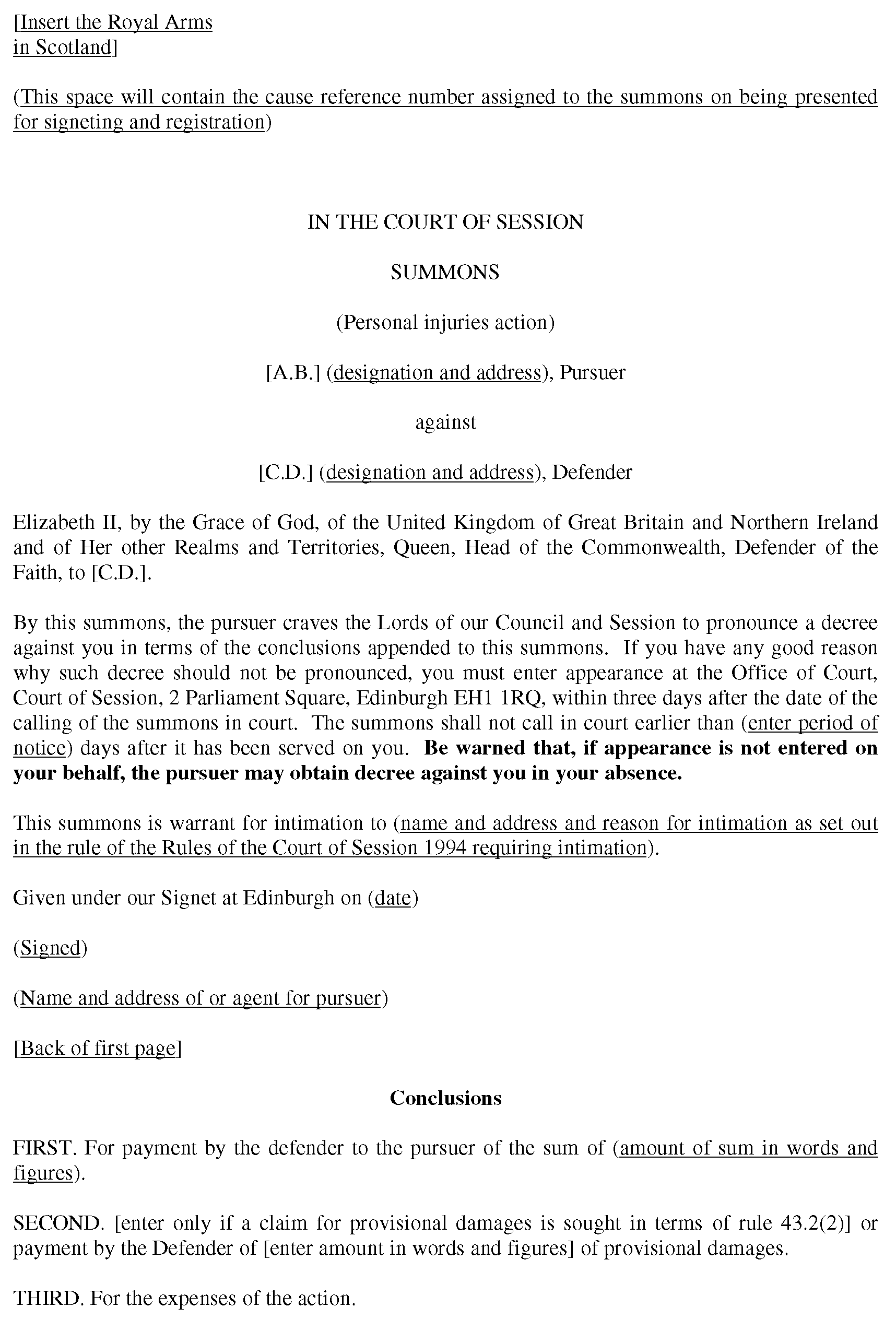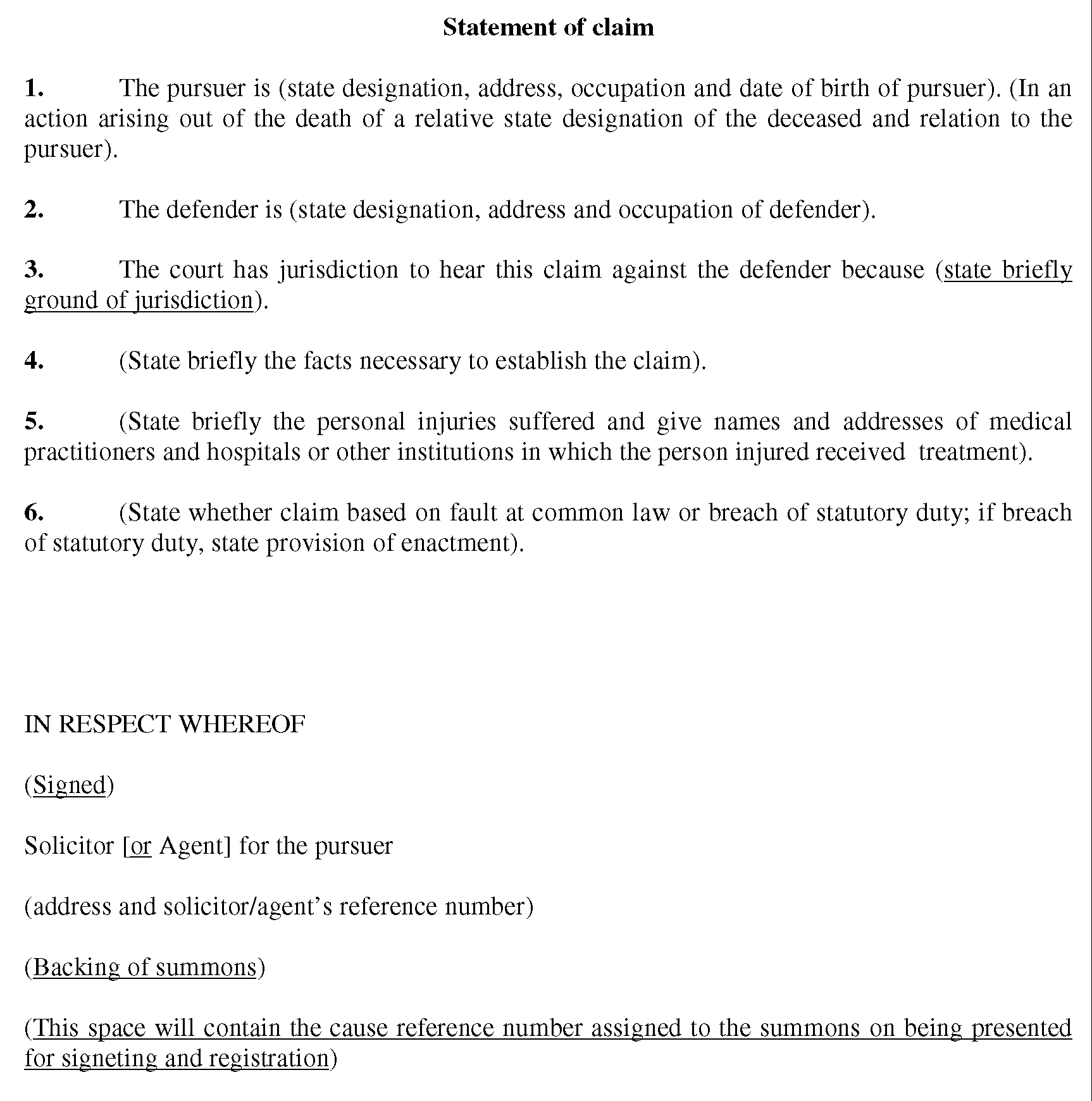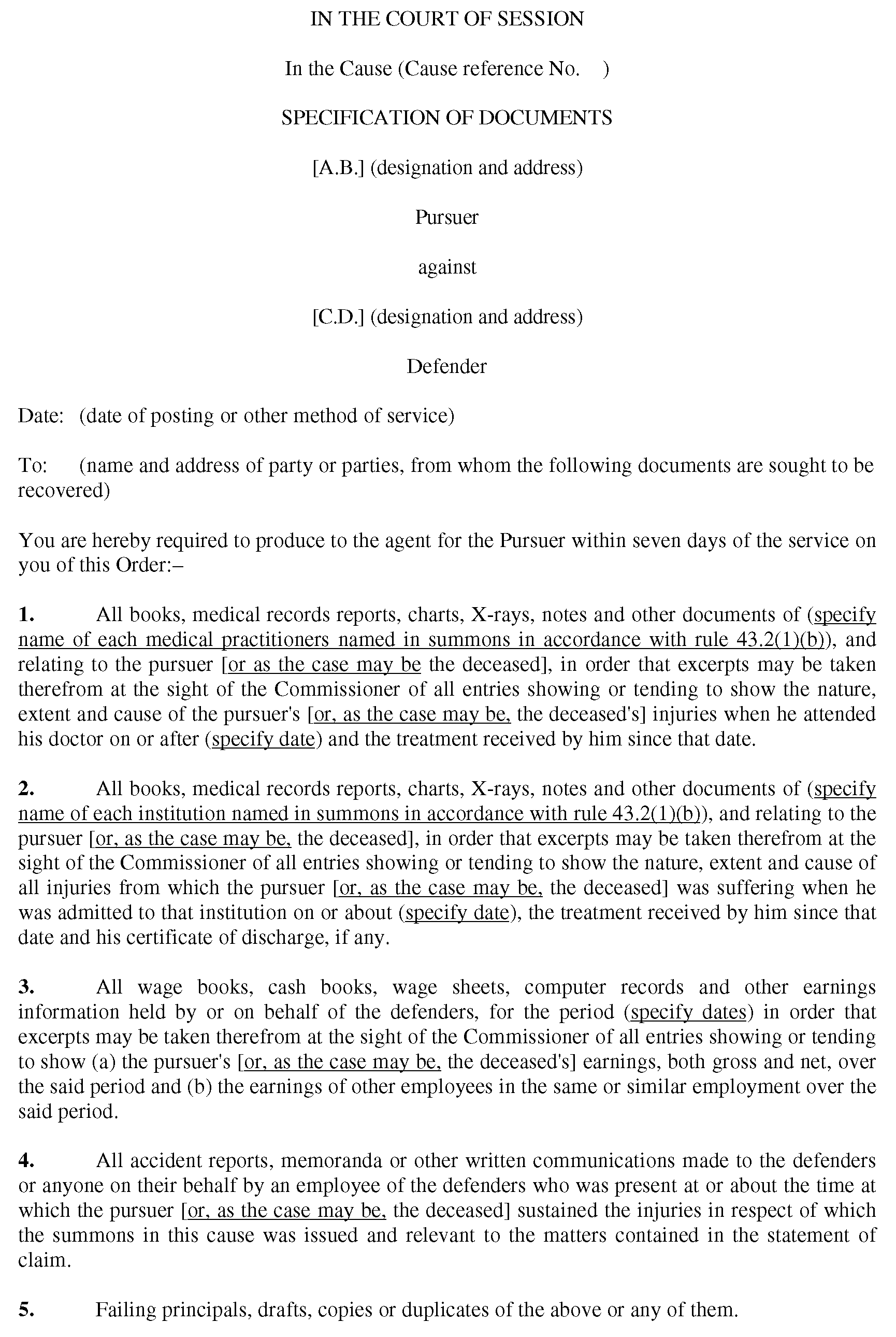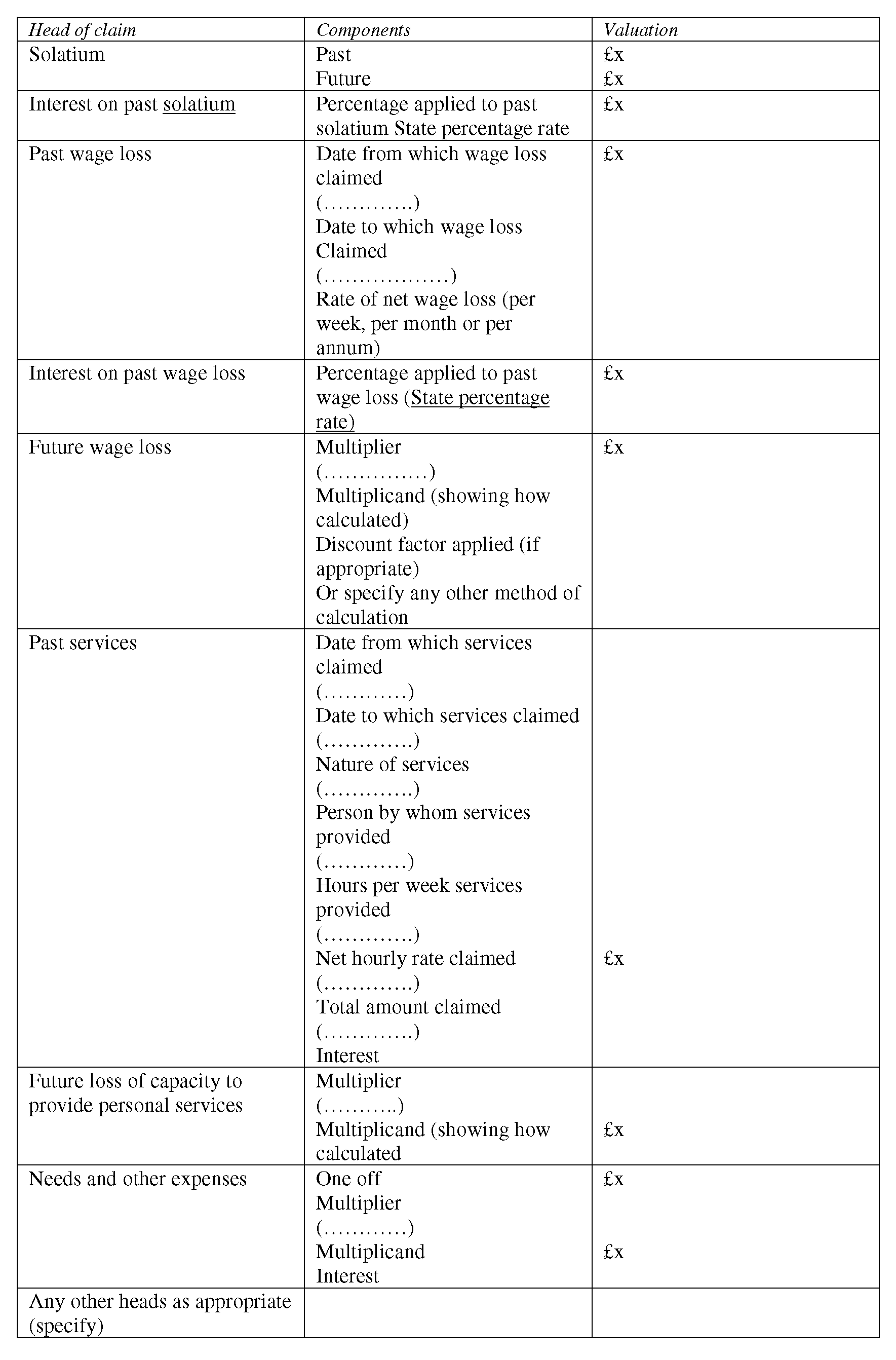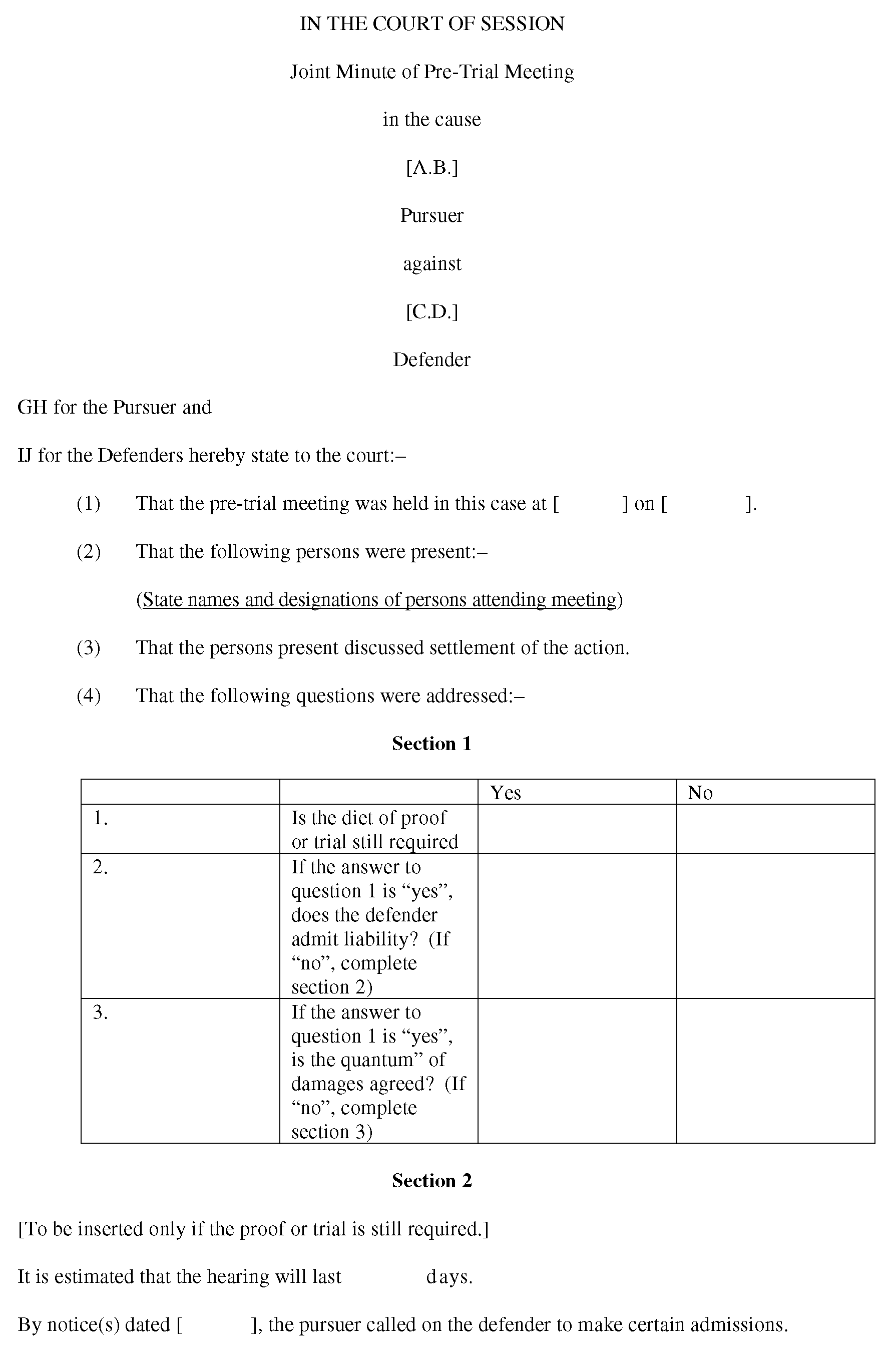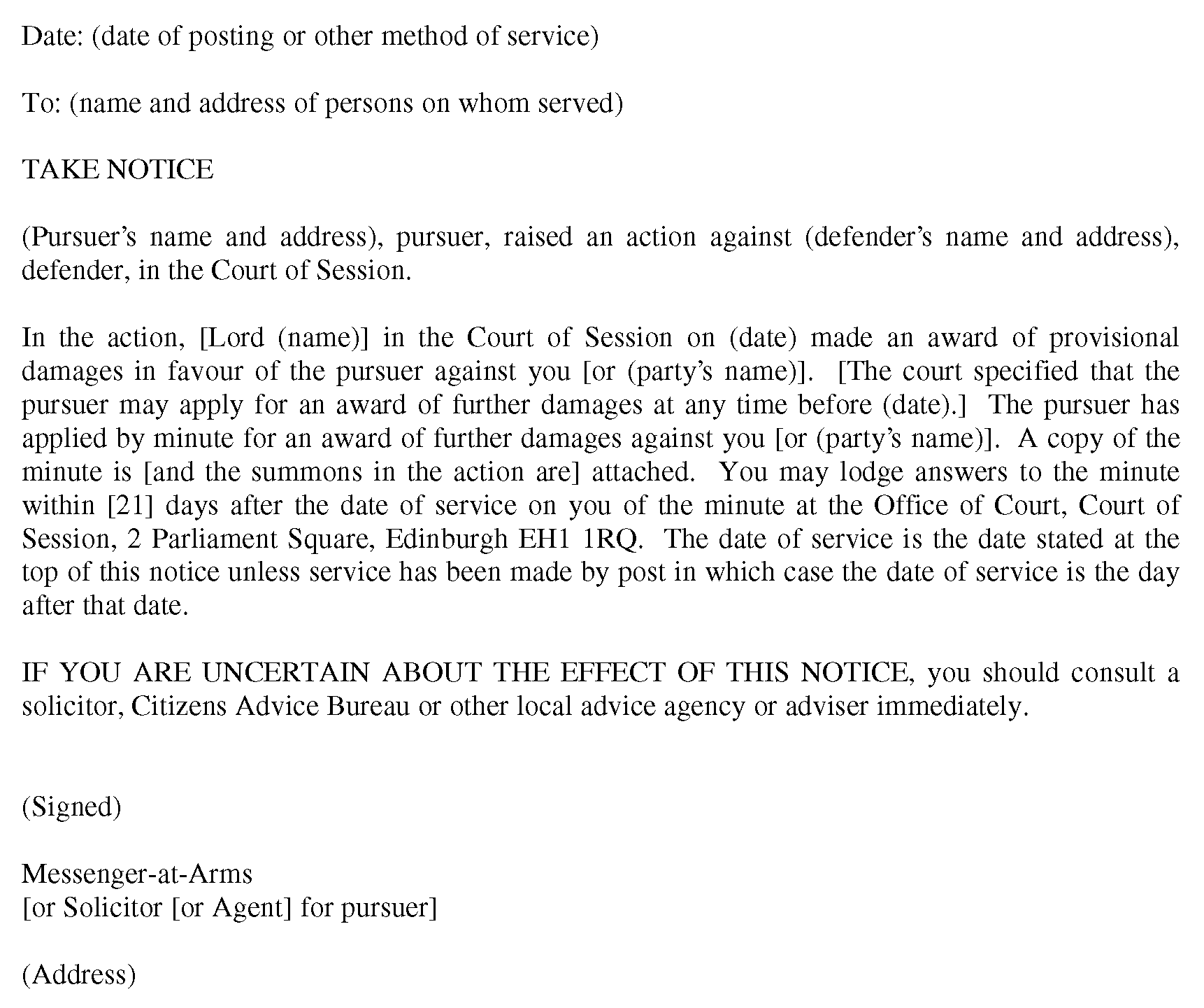- Latest available (Revised)
- Original (As made)
Act of Sederunt (Rules of the Court of Session Amendment No. 2) (Personal Injuries Actions) 2002
You are here:
- Scottish Statutory Instruments
- 2002 No. 570
- Whole Instrument
- Previous
- Next
More Resources
Status:
This is the original version (as it was originally made). This item of legislation is currently only available in its original format.
Scottish Statutory Instruments
2002 No. 570
COURT OF SESSION
Act of Sederunt (Rules of the Court of Session Amendment No. 2) (Personal Injuries Actions) 2002
Made
23rd December 2002
Coming into force
1st April 2003
The Lords of Council and Session, under and by virtue of the powers conferred upon them by section 5 of the Court of Session Act 1988(1) and of all other powers enabling them in that behalf, do hereby enact and declare:
Citation, commencement and interpretation
1.—(1) This Act of Sederunt may be cited as the Act of Sederunt (Rules of the Court of Session Amendment No. 2) (Personal Injuries Actions) 2002 and shall come into force on 1st April 2003.
(2) In this Act of Sederunt, “the principal Rules” means the Rules of the Court of Session 1994(2).
Procedure for actions of damages
2.—(1) For Chapter 43 of the principal Rules substitute–
“CHAPTER 43ACTIONS OF DAMAGES FOR, OR ARISING FROM, PERSONAL INJURIES
Application and interpretation of this chapter
43.1—(1) This Chapter applies to a personal injuries action.
(2) In this Chapter–
“connected person” means a person, not being a party to the action, who has title to sue the defender in respect of the personal injuries from which a deceased died or in respect of his death;
“personal injuries” includes any disease or impairment, whether physical or mental;
“personal injuries action” means an action of damages for, or arising from, personal injuries or death of a person from personal injuries; and
“relative” has the meaning assigned to it in Schedule 1 to the Damages (Scotland) Act 1976.
(3) The following rules shall not apply to an action to which this Chapter applies:–
(a)rule 4.9(2) (prorogation of time for lodging document);
(b)rule 6.2 (fixing and allocation of diets in the Outer House);
(c)rule 13.2 (form of summons);
(d)rule 13.6(b) (arrestment to found jurisdiction);
(e)rule 13.7 (service and intimation of summons);
(f)rule 13.13(6) (calling);
(g)rule 22.1 (open records);
(h)rule 22.2 (time for adjustments on Adjustment Roll);
(j)rule 22.3 (closing of record);
(k)rule 36.3 (lodging of productions).
Form of summons
43.2—(1) The summons shall be in Form 43.2-A and there shall be annexed to it a brief statement containing–
(a)averments in numbered paragraphs relating only to those facts necessary to establish the claim; and
(b)the names of every medical practitioner from whom, and every hospital or other institution in which, the pursuer or, in an action in respect of the death of a person, the deceased received treatment for the personal injuries.
(2) An application for an order under section 12(2)(a) of the Administration of Justice Act 1982(3) (provisional damages for personal injuries) shall be made by including in the summons a conclusion for provisional damages; and, where such an application is made, averments as to the matters referred to in paragraphs (a) and (b) of section 12(1) of that Act shall be included in the statement made under paragraph (1)(a).
(3) In paragraph (2) above “provisional damages” means the damages referred to in section 12(4)(a) of the Administration of Justice Act 1982.
(4) A summons may include–
(a)warrants for intimation in so far as permitted under these Rules; and
(b)a specification of documents in Form 43.2-B.
(5) In relation to an action to which this Chapter applies, any references to the condescendence of a summons and to articles of the condescendence shall be construed as a reference to the statement required under paragraph (1) above and numbered paragraphs of that statement.
Service and calling of summons
43.3—(1) Where a summons in an action to which this Chapter applies is to be executed, a copy of the summons which has passed the signet shall be–
(a)served on the defender with a citation in Form 43.3 attached to it; and
(b)intimated to any person named in a warrant for intimation.
(2) Where a summons has not called within three months and a day after the date of signeting, the instance shall fall.
(3) Where a summons cannot be served within the period of notice determined in accordance with rule 13.4 and called before the expiry of the period mentioned in paragraph (2), the Court may–
(i)on the application of the pursuer by motion; and
(ii)on cause shown,
extend that period.
(4) An application under paragraph (3) shall be made before the expiry of the period mentioned in paragraph (2).
Inspection and recovery of documents
43.4—(1) This rule applies where the summons contains a specification of documents by virtue of rule 43.2(4)(b).
(2) Upon signet an order granting commission and diligence for the production and recovery of the documents mentioned in the specification shall be granted and the Deputy Principal Clerk of Session shall certify Form 43.2-B to that effect.
(3) An order under paragraph (2) shall be treated for all purposes as an interlocutor of the court granting commission and diligence signed by the Lord Ordinary.
(4) The pursuer may serve an order under paragraph (2) and the provisions of rule 35.2 shall thereafter apply, subject to any necessary modifications, as if the order were an order obtained on an application made under rule 35.2(1)(a).
(5) Nothing in this rule shall affect the right of a party to apply under rule 35.2 for a commission and diligence for recovery of documents or for an order under section 1 of the Administration of Justice (Scotland) Act 1972 in respect of any document or other property not mentioned in the specification annexed to the summons.
Motions to dispense with timetable
43.5—(1) Any party to an action may, within 28 days of the lodging of defences, by motion apply to have the action withdrawn from the procedure in this Chapter and to be appointed to proceed as an ordinary action.
(2) No motion under paragraph (1) shall be granted unless the court is satisfied that there are exceptional reasons for not following the procedure in this Chapter.
(3) In determining whether there are exceptional reasons justifying the granting of a motion made under paragraph (1), the Lord Ordinary shall have regard to–
(a)the likely need for detailed pleadings;
(b)the length of time required for preparation of the action; and
(c)any other relevant circumstances.
(4) Where the court appoints the cause to proceed as an ordinary action under paragraph (1)–
(a)the pursuer shall, within seven days, lodge an open record in terms of rule 22.1; and
(b)rules 43.11, 43.12 and 43.13 shall apply to the action.
Allocation of diets and timetables
43.6—(1) The Keeper of the Rolls shall, on the lodging of defences or, where there is more than one defender the first lodging of defences–
(a)allocate a diet for proof of the action;
(b)issue a timetable stating the date mentioned in sub-paragraph (a) and calculated by reference to periods specified from time to time by the Lord President, in accordance with which–
(i)an application for a third party notice under rule 26.1 may be made;
(ii)the pursuer may execute a commission for recovery of documents under rule 43.4;
(iii)parties may adjust their pleadings;
(iv)the pursuer shall lodge a statement of valuation of claim in process;
(v)the pursuer shall lodge a record;
(vi)the defender (and any third party to the action) shall lodge a statement of valuation of claim in process;
(vii)the parties shall each lodge in process a list of witnesses together with any productions upon which they wish to rely; and
(viii)the pursuer shall lodge in process the minute of the pre-trial meeting.
(2) A timetable issued under paragraph (1) shall be in Form 43.6 and shall be treated for all purposes as an interlocutor of the court signed by the Lord Ordinary; and so far as the timetable order is inconsistent with any provision in these rules which relates to a matter to which the timetable relates, the timetable shall prevail.
(3) Where a party fails to comply with any requirement of a timetable other than that referred to in paragraph (7), the Keeper of the Rolls may put the cause out to be heard on the By Order roll.
(4) The pursuer shall lodge two copies of the record, which shall consist of the pleadings of the parties, in process by the date specified in the timetable and shall at the same time send one copy to the defender and any other parties.
(5) The pursuer shall, on lodging the copies of the record as required by paragraph (4), enrol a motion craving the court–
(a)to allow to parties a preliminary proof on specified matters;
(b)to allow a proof;
(c)to allow issues for jury trial; or
(d)to make some other specified order.
(6) In the event that any party proposes to ask the court to make any order other than one of those specified in sub-paragraphs (b) or (c) of paragraph (5), that party shall, on enrolling or opposing (as the case may be) the pursuer’s motion, specify the order to be sought and give full notice in the motion or notice of opposition, of the grounds thereof.
(7) Where a pursuer fails to lodge a record by the date specified in a timetable issued under paragraph (1), the Keeper of the Rolls shall put the case out to be heard on the By Order roll.
(8) A production which is not lodged in accordance with paragraph (1)(b)(vii) shall not be used or put in evidence at a proof unless–
(a)by consent of parties; or
(b)with the leave of the court on cause shown and on such conditions, if any, as to expenses or otherwise as the court thinks fit.
(9) In a cause which is one of more than one cause arising out of the same cause of action, the court may–
(a)on the motion of a party to that cause; and
(b)after hearing parties to all those causes,
appoint that cause or any other of those causes to be the leading cause and to sist the other causes pending the determination of the leading cause.
(10) In this rule, “pursuer ” includes additional pursuer, noter or minuter, as the case may be.
Hearings on the By Order roll
43.7 •
(1) Where the Keeper of the Rolls puts a case out to be heard on the By Order roll under paragraphs (3) or (7) of rule 43.6 or paragraph (3) of rule 43.10 he shall–
(a)put the cause out to be heard not less than seven days after the date of the notice referred to in sub-paragraph (b) on the By Order roll; and
(b)give notice to the parties to the action–
(i)of the date of the hearing of the cause on the By Order roll; and
(ii)requiring the party in default to lodge in process a written explanation as to why the timetable has not been complied with and to intimate a copy to all other parties, not less than two clear working days before the date of the hearing.
(2) At a hearing on the By Order roll under any of the provisions mentioned in the foregoing paragraph, the Lord Ordinary–
(a)shall consider any explanation provided by the party in default;
(b)may award expenses against that party; and
(c)may make any other appropriate order, including decree of dismissal.
(3) Expenses awarded under paragraph (2)(b) shall not exceed the expenses of the process before the date of the hearing on the By Order roll.
Applications for sist or for variation of timetable order
43.8—(1) The action may be sisted or the timetable issued under rule 43.6 may be varied by the court on an application by any party to the action by motion.
(2) An application under paragraph (1)–
(a)shall be placed before the Lord Ordinary; and
(b)shall be granted only on special cause shown.
(3) Any sist of an action shall be for a specific period.
(4) Where a timetable issued under rule 43.6 is varied under this rule, the Keeper of the Rolls shall issue a revised timetable in Form 43.6.
(5) A revised timetable issued under paragraph (4) shall have effect as if it were a timetable issued under rule 43.6 and any reference in this Chapter to any action being taken in accordance with the timetable shall be construed as a reference to its being taken in accordance with the timetable as varied under this rule.
Statements of valuation of claim
43.9—(1) Each party to an action shall make a statement of valuation of claim in Form 43.9.
(2) A statement of valuation of claim (which shall include a list of supporting documents) shall be lodged in process.
(3) Each party shall, on lodging a statement of valuation of claim, give written intimation to every other party of the list of documents included in the statement of valuation of claim.
(4) A party who has received intimation of a list of documents from another party under paragraph (3) may on written request made within 14 days after the receipt of the list, inspect those documents which–
(a)have not been lodged in process; and
(b)are in the possession or control of the party intimating the list.
(5) A party inspecting documents under paragraph (4) shall have the right to obtain a copy or copies of any such document on payment of a copying fee of not more than that prescribed in Chapter I of the Table of Fees in rule 42.16.
(6) Nothing in paragraphs (3) to (5) shall affect–
(a)the law relating to, or the right of a party to object to the inspection of a document on the ground of, privilege or confidentiality; or
(b)the right of a party to apply under rule 35.2 for a commission and diligence for recovery of documents or an order under section 1 of the Administration of Justice (Scotland) Act 1972.
(7) Without prejudice to paragraph (2) of rule 43.7 (hearings on the By Order roll), where a party has failed to lodge a statement of valuation of claim in accordance with a timetable issued under paragraph (2) of rule 43.6 (allocation of diets and timetables) the court may at a hearing of the cause on the By Order roll under paragraph (3) of that rule–
(a)where the party in default is the pursuer, dismiss the action; or
(b)where the party in default is the defender, grant decree against the defender for an amount not exceeding the amount of the pursuer’s valuation.
Pre-trial meetings
43.10—(1) For the purposes of this rule, a pre-trial meeting is a meeting between the parties, which shall be held not later than four weeks before the date assigned for the proof or trial to discuss–
(a)settlement of the action; and
(b)to agree, so far as is possible, the matters which are not in dispute between them.
(2) A joint minute of a pre-trial meeting, made in Form 43.10, shall be lodged in process by the pursuer not less than three weeks before the date assigned for the proof or trial.
(3) Where a joint minute in Form 43.10 has not been lodged in accordance with paragraph (2) and by the date specified in the timetable order the Keeper of the Rolls shall put the case out to be heard on the By Order roll.
(4) During the pre-trial meeting, the representative of each party to the action shall have access to the party or another person who has authority to commit the party in the settlement of the action.
Applications for interim payments of damages
43.11—(1) A pursuer may, at any time after defences have been lodged, apply by motion for an order for interim payment of damages to him by the defender or, where there are two or more of them, by any one or more of them.
(2) The pursuer shall give written intimation of a motion under paragraph (1) to every other party not less than 14 days before the date on which the motion is enrolled.
(3) On a motion under paragraph (1), the court may, if satisfied that–
(a)the defender or, where there are two or more of them, any one or more of them, has admitted liability to the pursuer in the action; or
(b)if the action proceeded to proof, the pursuer would succeed in the action on the question of liability without any substantial finding of contributory negligence on his part, or on the part of any person in respect of whose injury or death the claim of the pursuer arises, and would obtain decree for damages against any defender,
ordain that defender to make an interim payment to the pursuer of such amount as it thinks fit, not exceeding a reasonable proportion of the damages which, in the opinion of the court, are likely to be recovered by the pursuer.
(4) Any such payment may be ordered to be made in one lump sum or otherwise as the court thinks fit.
(5) No order shall be made against a defender under this rule unless it appears to the court that the defender is–
(a)a person who is insured in respect of the claim of the pursuer;
(b)a public authority; or
(c)a person whose means and resources are such as to enable him to make the interim payment.
(6) Notwithstanding the grant or refusal of a motion for an interim payment, a subsequent motion may be made where there has been a change of circumstances.
(7) Subject to Part IV (management of money payable to children), any interim payment shall be made to the pursuer unless the court otherwise directs.
(8) This rule shall, with the necessary modifications, apply to a counterclaim for damages for personal injuries made by a defender.
(9) In this rule “defender” includes a third party against whom the pursuer has a conclusion for damages.
Adjustment on final decree
43.12 Where a defender has made an interim payment order under rule 43.11(3), the court may make such order, when final decree is pronounced, with respect to the interim payment as it thinks fit to give effect to the final liability of that defender to the pursuer; and in particular may order–
(a)repayment by the pursuer of any sum by which the interim payment exceeds the amount which that defender is liable to pay the pursuer; or
(b)payment by any other defender or a third party of any part of the interim payment which the defender who made it is entitled to recover from him by way of contribution or indemnity or in respect of any remedy or relief relating to, or connected with, the claim of the pursuer.
Applications for further damages
43.13—(1) An application for further damages by a pursuer in respect of whom an order under section 12(2)(b) of the Administration of Justice Act 1982 has been made shall be made by minute and shall include–
(a)a conclusion in Form 43.13-A; and
(b)averments in the statement of facts supporting that conclusion.
(2) On lodging such a minute in process, the pursuer shall apply by motion for warrant to serve the minute on–
(a)every other party; and
(b)where such other party is insured or otherwise indemnified, his insurer or indemnifier, if known to the pursuer.
(3) A notice of intimation in Form 43.13-B shall be attached to the copy of the minute served on a warrant granted on a motion under paragraph (2).
(4) Any such party, insurer or indemnifier may lodge answers to such a minute in process within 28 days after the date of service on him.
Actions by connected persons
43.14—(1) In an action of damages in which, following the death of any person from personal injuries, damages are claimed–
(a)by the executor of the deceased, in respect of the injuries from which the deceased died; or
(b)by any relative of the deceased, in respect of the death of the deceased,
the pursuer shall make the averments specified in paragraph (2).
(2) The pursuer in an action to which paragraph (1) applies shall aver in the condescendence, as the case may be–
(a)that there are no connected persons;
(b)that there are connected persons, being persons specified in the warrant for intimation; or
(c)that there are connected persons in respect of whom intimation should be dispensed with on the ground that–
(i)the names or whereabouts of such persons are not known to, and cannot reasonably be ascertained by, the pursuer; or
(ii)such persons are unlikely to be awarded more than the sum of £200 each.
Warrants for intimation in actions by connected persons
43.15—(1) Where the pursuer makes averments under rule 43.14(2)(b) (existence of connected persons), he shall insert a warrant for intimation in the summons in the following terms:–
“Warrant to intimate to (name and address) as a person who is believed to have title to sue the defender in an action in respect of the personal injuries from which the late (name and last place of residence) died [or the death of the late (name and last place of residence)]”.
(2) A notice of intimation in Form 43.15 shall be attached to the copy of the summons where intimation is given on a warrant under paragraph (1).
Applications to dispense with intimation in actions by connected persons
43.16—(1) Where the pursuer makes averments under rule 43.14(2)(c) (dispensing with intimation to connected persons), he shall apply by motion for an order to dispense with intimation.
(2) In determining a motion under paragraph (1), the court shall have regard to–
(a)the desirability of avoiding multiplicity of actions; and
(b)the expense, inconvenience or difficulty likely to be involved in taking steps to ascertain the name or whereabouts of the connected person.
(3) Where the court is not satisfied that intimation to a connected person should be dispensed with, it may–
(a)order intimation to a connected person whose name and whereabouts are known;
(b)order the pursuer to take such further steps as it may specify in the interlocutor to ascertain the name or whereabouts of any connected person; and
(c)order that such advertisement be made in such manner, in such place and at such times as it may specify in the interlocutor.
Subsequent disclosure of connected persons
43.17 Where the name or whereabouts of a person, in respect of whom the court has dispensed with intimation on a ground specified in rule 43.14(2)(c) (dispensing with intimation to connected persons), subsequently becomes known to the pursuer while the action is depending before the court, the pursuer shall apply by motion under rule 13.8(1) (warrants after signeting) for a warrant for intimation to such a person; and such intimation shall be made in accordance with rule 43.15(2).
Connected persons entering the process
43.18—(1) A connected person may apply to the court by minute in the process of the action craving leave to be sisted as an additional pursuer to the action.
(2) Any such minute shall be placed before the Lord Ordinary who may grant the minute and shall make such order as he considers appropriate, having regard to the provisions in this Chapter.
Failure by connected person to enter process
43.19—(1) Where a connected person to whom intimation is made–
(a)does not apply to be sisted as an additional pursuer to the action;
(b)subsequently brings a separate action against the same defender in respect of the same personal injuries or death; and
(c)would, apart from this rule, be awarded the expenses or part of the expenses of that action,
he shall not be awarded those expenses except on cause shown.”.
(2) In the Appendix to the principal Rules, for Forms 43.3 to 43.18 substitute the forms set out in the Schedule to this Act of Sederunt.
Transitional and saving provision
3. This Act of Sederunt shall not apply to an action raised before 1st April 2003.
W. Douglas Cullen
Lord President, I.P.D.
Edinburgh,
23rd December 2002
SCHEDULE
Explanatory Note
(This note is not part of the Act of Sederunt)
This Act of Sederunt introduces new rules of procedure for personal injury actions.
The rules of procedure enacted by this Act of Sederunt apply to a personal injury action raised on or after 1st April 2003. A personal injury action commenced before 1st April 2003 will be governed by the rules of procedure in force prior to that date.
1988 c. 36; section 5 was amended by the Civil Evidence (Scotland) Act 1988 (c. 32), section 2(3) and by the Children (Scotland) Act 1995 (c. 36), Schedule 4, paragraph 45.
SI 1994/1443, to which there are amendments not relevant to this Act of Sederunt.
1982 c. 53, to which there are amendments not relevant to this Act of Sederunt.
Options/Help
Print Options
PrintThe Whole Instrument
Legislation is available in different versions:
Latest Available (revised):The latest available updated version of the legislation incorporating changes made by subsequent legislation and applied by our editorial team. Changes we have not yet applied to the text, can be found in the ‘Changes to Legislation’ area.
Original (As Enacted or Made): The original version of the legislation as it stood when it was enacted or made. No changes have been applied to the text.
More Resources
Access essential accompanying documents and information for this legislation item from this tab. Dependent on the legislation item being viewed this may include:
- the original print PDF of the as enacted version that was used for the print copy
- lists of changes made by and/or affecting this legislation item
- confers power and blanket amendment details
- all formats of all associated documents
- correction slips
- links to related legislation and further information resources
More Resources
Use this menu to access essential accompanying documents and information for this legislation item. Dependent on the legislation item being viewed this may include:
- the original print PDF of the as made version that was used for the print copy
- correction slips
Click 'View More' or select 'More Resources' tab for additional information including:
- lists of changes made by and/or affecting this legislation item
- confers power and blanket amendment details
- all formats of all associated documents
- links to related legislation and further information resources
